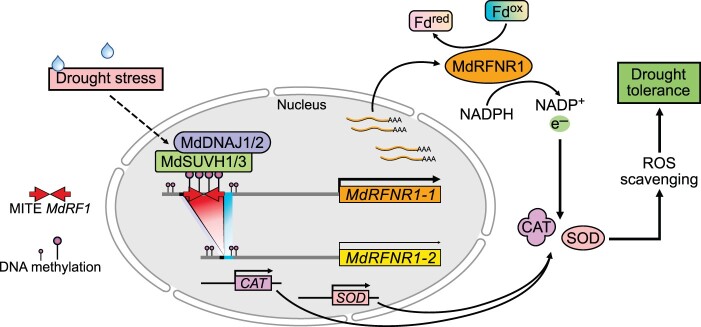Transposable elements (TEs) are considered genomic troublemakers—disrupting genome integrity if not kept in check. However, they can also create genetic and epigenetic variations that lead to new gene expression patterns. For instance, apical dominance in maize and the red color of blood orange are mediated by TE insertions (Doebley et al., 1997; Butelli et al., 2012). Therefore, TEs are not only detrimental, as they can drive evolution through gene regulatory changes.
In this issue, Chundong Niu, Lijuan Jiang, Fuguo Cao, and colleagues (Niu et al., 2022) provide another example of how a TE insertion can impact gene expression, here, by harboring cis-regulatory elements that mediate the drought stress response in apple (Figure). Drought stress disrupts redox reactions, affecting the balance of harmful reactive oxygen species (ROS). Among the enzymes mediating redox reactions, the root ferredoxin-NADP+ oxidoreductases (RFNRs) catalyze the reduction of ferredoxin in nonphotosynthetic plastids. The team found that the expression of RFNR1 in apple is upregulated across the whole plant upon drought stress treatment. They cloned the gene from a commercial apple variety and found two alleles diverging at three amino acids: MdRFNR1-1 and MdRFNR1-2. They showed that both alleles encode a functional RFNR able to catalyze redox reactions in vitro and confer drought tolerance in transformed apple calli when expressed constitutively. In addition, they generated transgenic apple plants with either increased or decreased expression of MdRFNR1-1, showing enhanced or reduced tolerance to drought stress, respectively.
Figure.
Drought stress upregulates MdRFNR1-1 gene expression by promoting the binding of MdSUVH1/3 and MdDNAJ1/2 to the methylated MITE insertion upstream of MdRFNR1-1. Subsequently, MdRFNR1 is involved in a cascade of redox reactions that scavenge excess ROS generated during drought stress. Reprinted from Niu et al. (2022), Figure 11.
Looking carefully at the two alleles of MdRFNR1, the researchers identified a 430-bp miniature inverted-repeat TE (MITE) insertion in the promotor of MdRNFR1-1. They found this MITE insertion in 30 out of 371 Malus accessions genotyped by polymerase chain reaction (PCR). They then looked at the expression difference between the two alleles and found that MdRFNR1-1 is more highly expressed in the root and could be further induced by drought stress in vitro. To test whether the MITE insertion mediates drought stress induction of MdRFNR1 expression, they transformed apple calli with a beta-glucuronidase (GUS) reporter gene driven by the promoter of MdRNFR1-1 with and without the MITE insertion. They showed that GUS expression is induced by drought stress only when the MITE insertion is present, confirming its role in cis-regulation.
The MITE insertion is associated with 24-nt small RNAs and DNA methylation. Reducing DNA methylation using a methyltransferase inhibitor leads to a reduction of MdRFNR1-1 expression upon drought stress. Although DNA methylation at cis-regulatory regions is usually associated with transcriptional silencing, specific transcription factors such as SUVH1 and SUVH3 in Arabidopsis bind preferentially to methylated DNA and promote transcription through the recruitment of DNAJ1 and DNAJ2 transcriptional activators (Harris et al., 2018). Niu et al. identified four homologs for the SUVH1 and SUVH3 and five homologs of DNAJ1 and DNAJ2 in the apple genome. They confirmed interactions between five of the nine homologs using yeast two-hybrid assays and split luciferase interaction assays. They also showed that MdSUVH1 and MdSUVH3 bind preferentially to the methylated MITE insertion using DNA affinity purification sequencing. Finally, they used a dual luciferase reporter assay to show that combining MdSUVH1 with any of the MdDNAJ homologs increases luciferase expression in infiltrated tobacco leaves, indicating that MdDNAJ homologs have a redundant function in MdSUVH1-mediated activation of MdRFNR1-1 expression.
Together, these data strongly support the role of the MITE insertion in cis-regulation of MdRFNR1-1 in drought stress conditions (Figure). This work provides an additional case where a TE insertion and DNA methylation are positively associated with transcription, reminding us that nature is not black and white.
References
- Butelli E, Licciardello C, Zhang Y, Liu J, Mackay S, Bailey P, Reforgiato-Recupero G, Martin C (2012) Retrotransposons control fruit-specific, cold-dependent accumulation of anthocyanins in blood oranges. Plant Cell 24: 1242–1255 [DOI] [PMC free article] [PubMed] [Google Scholar]
- Doebley J, Stec A, Hubbard L (1997) The evolution of apical dominance in maize. Nature 386: 485–488 [DOI] [PubMed] [Google Scholar]
- Harris CJ, Scheibe M, Wongpalee SP, Liu W, Cornett EM, Vaughan RM, Li X, Chen W, Xue Y, Zhong Z, et al. (2018) A DNA methylation reader complex that enhances gene transcription. Science 362: 1182–1186 [DOI] [PMC free article] [PubMed] [Google Scholar]
- Niu C, Jiang L, Cao F., Liu C, Guo J, Zhang Z, Yue Q, Hou N, Liu Z, Li X, et al. (2022) Methylation of a MITE insertion in MdRFNR1-1 promoter is positively associated with its allelic expression in response to drought and drought tolerance. Plant Cell 34: 3983--4006 [DOI] [PMC free article] [PubMed] [Google Scholar]



